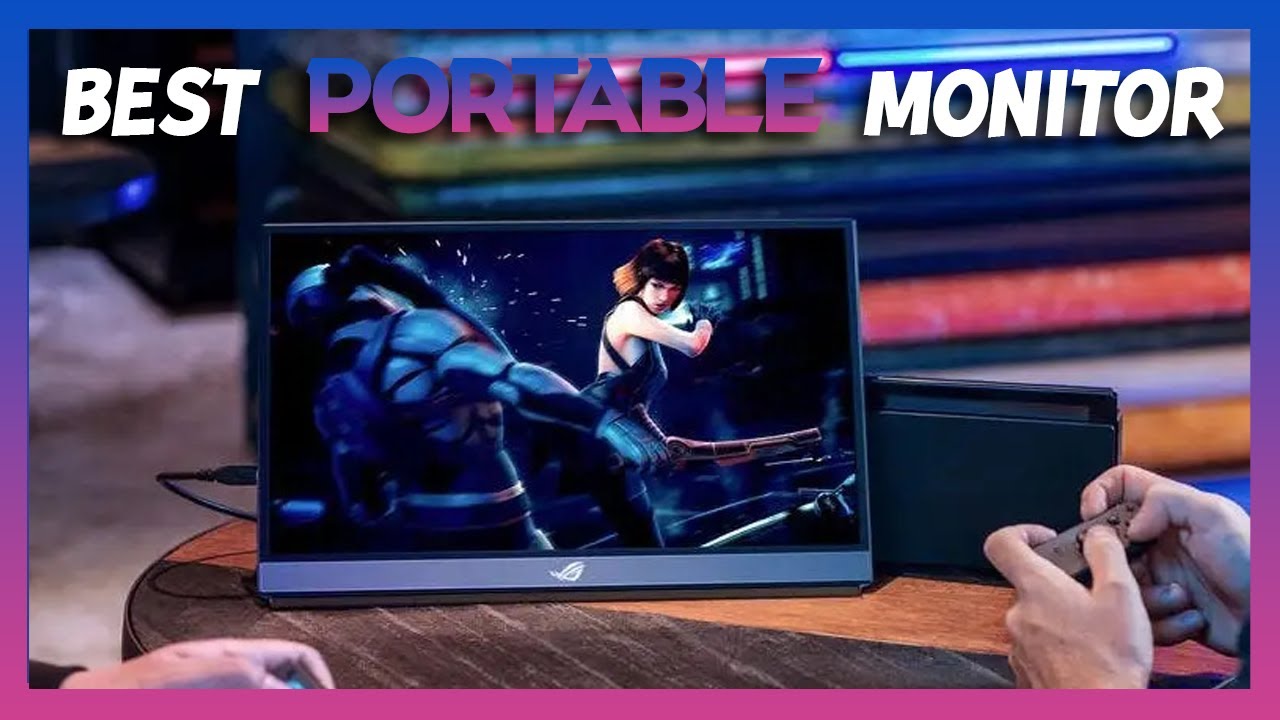Although they are not particularly new, the number of portable displays that are compatible with laptops has skyrocketed in recent years. (Most manufacturers of displays now offer many throughout their product lines.) You may discover a mobile monitor that is ready to go, regardless of whether you want to add another display to do presentations to small groups, watch two applications side by side in full screen, or use a stylus to make adjustments to designs. Here’s where Thegadgetex can help: We’ve conducted tests to find the top portable monitors for a range of applications. The ViewSonic VG1655 is our top choice overall for the majority of users, but one of the other options below, supported by our extensive testing procedures and combined decades of review knowledge, might be a better fit for your particular demands and budget. We We stand behind them all. Read on for the best portable monitors on the market, followed by our detailed shopping advice.
Last update on 2024-07-24 / Affiliate links / Images from Amazon.
Deeper Dive: Our Top Tested Picks
NO1- ViewSonic VG1655
- ULTRA-PORTABLE MONITOR: 15.6 Inch Full HD (1920x1080p) IPS portable monitor with a premium aluminum design, and a 60Hz refresh rate
- SMALL AND COMPACT: With a weight of 1.8 lbs and a thickness of 0.6 in, this portable monitor is easy to take on the go for added screen real estate
- LESS CABLE CLUTTER: USB-C connectivity for fast data, audio and video transfer, and 60W charging over one cable, or passthrough power when using the included power adapter
Last update on 2024-07-24 / Affiliate links / Images from Amazon.
For a low-cost portable monitor, the ViewSonic VG1655 has some unusual features. A large tilt range is provided via an integrated, foldable stand. You may access a comprehensive and advanced onscreen display (OSD) menu system with a five-way mini-joystick controller. A micro HDMI connector, two USB-C connectors (one for power and the other for data/video transfer), and two built-in speakers are also included. Though it is brighter than other mobile panels, its 15.6-inch 1080p IPS panel’s somewhat limited sRGB color-gamut coverage makes it more suited for standard commercial duties than color-sensitive workflows.
For consumers on a budget, the VG1655 is a suitable portable monitor for work or personal use, including email, web browsing, and producing and editing office-type documents.
Pros
- Built-in stand allows for easy fggdf
- Bright, with solid contrast ratio
- Good value for money
Cons
- Some colors dull in photos and video
No 2 : Asus ROG Strix XG16AHPE
- 17.3” Full HD (1920×1080) IPS portable gaming monitor with 240Hz refresh rate and 3ms (GTG) for super-smooth gaming visual
- Hybrid-signal USB-C and micro-HDMI ports provide versatile connectivity with smartphones, laptops, game consoles, cameras, tablets and more
- Adaptive-sync to deliver a seamless, tear-free gaming experience
Last update on 2024-07-24 / Affiliate links / Images from Amazon.
There are no important omissions on the 15-inch mobile monitor Asus ROG Strix XG16AHPE. Numerous gaming features, like a fast refresh rate, Nvidia G-Sync compatibility, and minimal input lag, are packed into this panel. In addition, the monitor features speakers, a kickstand, and an integrated battery. Rounding up its list of abilities are good brightness and a comparatively high contrast ratio. Although less important for games, its superb sRGB coverage only serves to increase its allure as a portable entertainment monitor in general.
For gamers and multimedia enthusiasts, the Asus ROG Strix XG16AHPE is a powerful, versatile portable display. It’s a great option for watching movies and photography because of its outstanding sRGB color coverage.
Pros
- High refresh rate and low input lag
- Built-in battery and speakers
- Bright (272 nits) and colorful (97.7% of sRGB)
- Kickstand works in both landscape and portrait modes
- Includes soft carrying sleeve
Cons
- Expensive for a 15.6-inch portable monitor
No : 3 ViewSonic VX1655-4K-OLED
- ULTRA-PORTABLE MONITOR: 15.6 Inch 4K UHD (3840x2160p) OLED portable monitor with 60Hz refresh rate and protective screen cover.
- SMALL AND COMPACT: With a weight of 1.5 lbs and a thickness of 0.6 in, this portable monitor slips easily into backpacks and purses
- LESS CABLE CLUTTER: USB-C connectivity for fast data, audio and video transfer, and 60W charging over one cable
Last update on 2024-07-24 / Affiliate links / Images from Amazon.
With a 15.6-inch UHD (4K) OLED screen that boasts incredible brightness, contrast, and color coverage, the ViewSonic VX1655-4K-OLED is maybe the most amazing portable monitor we have ever seen. The only significant drawback is that its ultra-high resolution and exceptional performance come at a price. Its higher pixel density than Apple creator monitors makes it especially useful for creative work. It’s also a good option for light gaming and viewing movies.
Creative professionals and affluent entertainment enthusiasts (movie goers and casual gamers) will benefit from the VX1655-4K-OLED. The ViewSonic VP16-OLED is a more than suitable alternative for people who cannot afford it; even on its 1080p screen, it is still bright but not glaringly so, and has a pixel density that is appropriate for graphic artists.
Pros
- OLED screen with superb brightness, contrast, color coverage
- High pixel density makes for sharp images
- Sturdy hinged stand enables screen tilt
- Two USB-C ports, each with 60-watt power delivery
Cons
- A bit pricey
- Joystick and ports inconvenient to access
No 4 : NexiGo NG17FGQ 17.3-Inch 300Hz Portable Monitor
- 【Industry Leading 300 Hz Refresh Rate】The NexiGo NG17FGQ portable gaming monitor is the first 17.3″ monitor in the world to deliver a 300 Hz refresh rate via USB-C port, 240Hz via HDMI port. It provides high-quality images with the least possible framerate lag with its 3ms response times. It features G-SYNC compatibility for flawlessly smooth and tear-free video for fast-paced video games.【Note】G-Sync is only available through the USB-C interface.
- 【17.3 Inch 1080P FHD Portable Gaming Monitor】Slim and lightweight, this portable monitor boasts a large 17.3 Inch screen with full IPS coverage. Built with an astounding 1,000:1 contrast ratio and with an amazing 178° viewing angle, this portable monitor delivers rich, vivid detail and 100% sRGB color space coverage to provide a deeper, more immersive experience.
- 【Eye Care Screen & HDR Technology】Eye care technology minimizes blue light to reduce eye strain. HDR technology creates an astounding picture with a stronger contrast, reduced flickering, increased dynamic range, and exceptional detail, to create the best possible viewing experience.
Last update on 2024-07-24 / Affiliate links / Images from Amazon.
Dedicated gamers seeking a high-refresh-rate panel they can carry with their gaming laptops will find the NexiGo NG17FGQ 17.3-Inch 300Hz Portable Monitor to be quite intriguing. An additional display for a home desktop or laptop, or paired with more advanced hardware like the PlayStation 5 or Nintendo Switch, the IPS panel performs admirably thanks to its AMD FreeSync support, surprisingly good color accuracy, and sky-high 300Hz peak refresh rate. The monitor’s shine was somewhat muted by its high price, absence of an internal battery, and mediocre construction, but not enough to detract from its overall outstanding performance.
Assuming you fit the description of this portable monitor—a die-hard gamer—the 17.3-inch NexiGo fulfills its claims of full HD with HDR, an exceptionally high refresh rate, and no compromise. Despite its low price, the build quality of this monitor is somewhat subpar, but its performance is excellent. When looking for peak refresh rates while on the go, esports gamers can find a reliable partner in the NexiGo 300Hz. Before proceeding, confirm that the source of your video can indeed achieve frame rates in the hundreds per second.
Pros
- High refresh rate
- Low measured input lag
- Impressive color accuracy
- Includes cover, carrying case, and cords for additional connections
Cons
- Flimsy build
- No internal battery
- Pricey
No 5 : Asus ZenScreen Touch (MB16AMT)
- 15.6” FHD IPS USB Type-C portable monitor with hybrid signal solution for compatibility with USB Type-C and Type-A sources (Note: DisplayLink driver needed for Type-A connection)
- Ultra-portable award-winning design at 2 pounds and 0.3 inches slim to pair perfectly with ASUS laptops, phones, tablets
- Built to be on-the-go with two integrated speakers and 7800mAh battery for ultimate compatibility
Last update on 2024-07-24 / Affiliate links / Images from Amazon.
The $349.99 Asus ZenScreen Touch (MB16AMT) differs from nearly every other mobile monitor we’ve evaluated in two ways. Its touch screen is one of its first features; the Wacom Cintiq Pro 17 and other interactive pen monitors have the same feature. Secondly, it comes with an integrated battery, which is quite helpful while watching media on your phone or when the battery on your laptop runs out of power. This 15.6-inch display is full of features and a pleasure to work with; it works well with Android phones and Windows PCs. It’s quite capable, but it’s not inexpensive.
If you require a portable monitor with a touch screen, be sure to check out the Asus ZenScreen Touch (MB16AMT); this model allows touch control with the accompanying pen/stylus eraser in addition to gesture-based multi-touch using your fingers.
Pros
- Gesture-based multi-t
- ouch and stylus input.
- Built-in battery.
- Comprehensive, easy-to-navigate menus, with mini-joystick for navigation.
- Good brightness and contrast ratio.
- Built-in speakers.
Cons
- Pricey for a mobile monitor.
- Somewhat dull colors.
- Limited touch support for use with Macs, and none for iOS devices.
Buying Guide: The Best Portable Monitors for 2024
When traveling, you could carry certain smaller desktop monitors with you, but “true” portable monitors are ones that are designed to be carried in a bag. Even those come in a wide variety of sizes: 3.5 inches to 22 inches. A wide range of portable displays are available, including panels for artists and gamers as well as personal, commercial, and multipurpose versions.
However, the ideal range of displays to utilize with a laptop is from 12 to 17 inches, which is what we’re concentrating on here. Many people align the screen size of their laptop with that of their portable display. However, a few versions of 10 inches (mostly for gaming consoles) and 7 inches (for the Raspberry Pi) are also available.
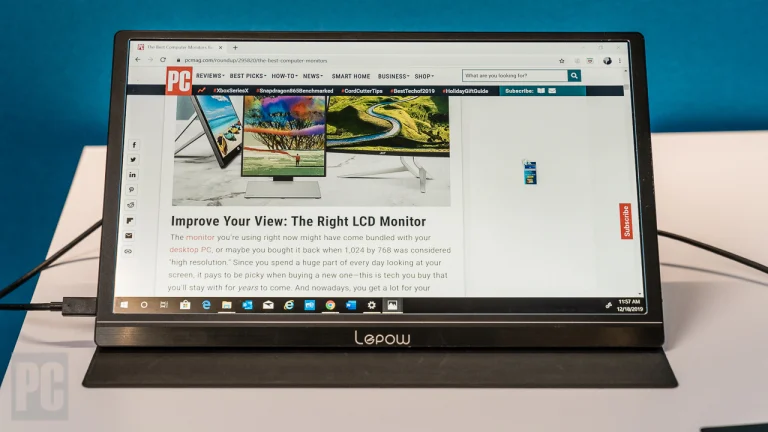
(Credit: Zlata Ivleva)
Many portable displays, particularly those that are more affordable, employ a support made of a rigid plastic board that is thin and folds into several creases and grooves. A magnetic strip has one end and is attached to the top of the monitor’s back. The monitor may be raised by folding the sheet in half so that the angle points away from the user. The monitor is secured and tilted upward by its bottom fitting into a groove. (Some portable displays have many grooves; by positioning the base in a different groove, you may change the tilt angle of the monitor.)
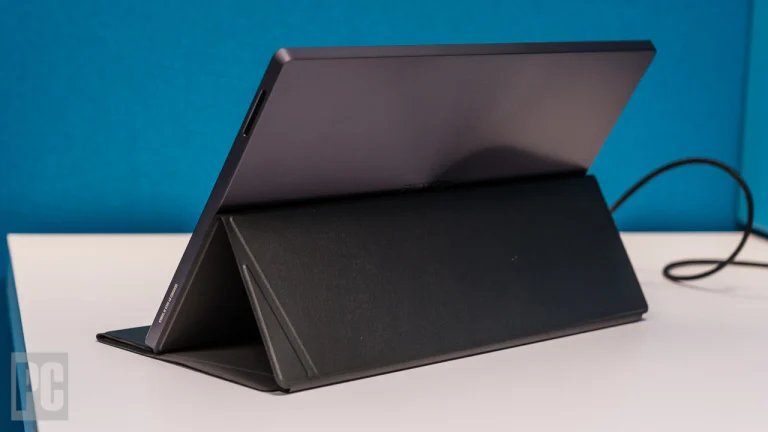
(Credit: Zlata Ivleva)
When not in use, these folding stands, also known as origami-style stands, can serve as protective coverings for the display. Certain models only shield the monitor’s front, while bigger wraparound coverings encase the entire device.
Another popular stand design, especially on more expensive versions, has the screen hinged to a flat, sturdy base that houses the ports. By tilting the screen, you may position it at any desired angle. Additionally, some designs attach to the back or side of the laptop and use it as support, sliding or swinging out as needed.
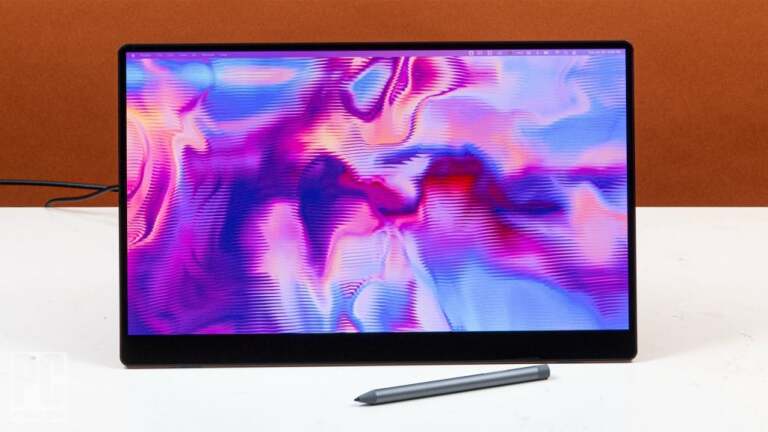
(Credit: Molly Flores)
Despite not having the same height, pivot, or swivel adjustments as desktop monitors, the majority of mobile displays are nonetheless lightweight and portable, making manual adjustment simple. While not all stands can hold a monitor in portrait position, certain displays may be manually rotated. You could always lean the monitor against a wall or another object in those situations. Whether in landscape or portrait mode, the majority of portable monitors have an automated picture correction feature that ensures the display is always oriented correctly. (In Windows display settings, you may adjust the orientation even in those without such automatic image rotation.)
The Best Portable Monitor for a Laptop: How to Evaluate the Screen
The primary aspects that we take into account when assessing mobile monitor panels are the panel’s technology, native resolution, brightness range, screen size and aspect ratio, and color-gamut coverage promises made by the manufacturer.
A lot of consumers would rather utilize a mobile display that matches the native resolution and screen size of their laptop. Having said that, I have discovered that these screens are rather tolerant and have had no issues using portable displays that are marginally bigger than the screen on my laptop. You should not have too much issue matching up the mobile monitor and laptop screen aspect ratios, as long as you don’t mismatch them (which, up until the last few years, was virtually always a 16:9 widescreen ratio but is now more commonly 16:10).
From 1,366 by 768 pixels (too coarse for current laptops) to 3,840 by 2,160 pixels (UHD, aka 4K), the native resolution on screens fit for laptop use ranges. The majority of modern laptop-compatible displays have a native resolution of 1,920 by 1,080 pixels, sometimes known as 1080p, or “full HD,” however others have greater resolutions.
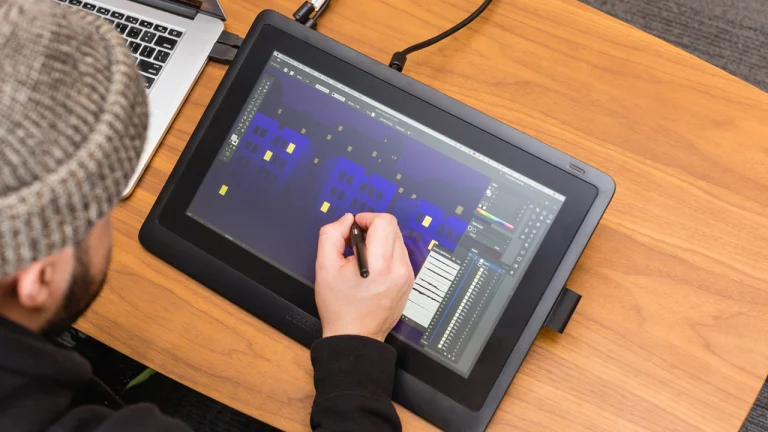
(Credit: Zlata Ivleva)
When it comes to brightness, mobile displays are often less bright than desktop monitors. Luminance, or brightness per unit area, is the true term for what is usually referred to as brightness. Although many portable monitors are rated between 230 and 300 nits, which is appropriate for everyday use, in our tests, they tend to cluster around 180 nits (also expressed as “candelas per meter squared”). The brightness of monitors has significantly increased with the introduction of portable OLED screens; the highest one we examined measured over 550 nits.
Due to its broader off-axis viewing angles and high color accuracy, in-plane switching (IPS) monitors are often chosen over vertical alignment (VA) and twisted-nematic (TN) panels for common usage. IPS is a common feature of modern mobile monitors, but there’s a catch—especially if the display was manufactured prior to 2022. The sRGB color space, which is the standard color space for the web and many other applications, is tested first when evaluating a panel’s color gamut. Practically any hue that can be created by combining red, green, and blue is included in this color space. At least 95% of sRGB is covered by most desktop monitors, and comparable coverage has been seen with certain portable displays.
But until a few years ago, the majority of the mobile IPS displays that we examined had very similar color profiles and far less comprehensive total color coverage (60% to 72% of sRGB), which meant that blue-greens were somewhat boosted and red and purple coverage was low. Despite being on displays manufactured by different manufacturers, these core panels most likely originated from the same or comparable sources because of their virtually matching “color signatures.”

(Credit: Molly Flores)
Our experience research confirmed these quantitative results, with red and purple regions seeming washed out and dull in images and movies. While most business and productivity uses of these screens are adequate, videophiles and picture aficionados will find them inferior. We include an examination of the panel’s color coverage along with a chromaticity chart that plots our measurements against the optimum values for the color space under test in our monitor evaluations. While color-gamut coverage on portable IPS panels has improved significantly in recent years, we still assess some with similar subpar color profiles from time to time.
What Ports Should I Look for in a Portable Monitor?
As I mentioned before, USB Type-C connection is enabling a convergence of power and communication in the realm of mobile monitors. Numerous USB-C ports allow data/video and power to pass through the port from a computer using a single USB cable since they enable DisplayPort over USB and USB power delivery. Several modern mobile displays connect only via USB-C, and the majority include at least one USB-C connection. Even while there is an allure to this simplicity, be sure the USB-C connector on your laptop can transport data, video, and power because some early-generation USB-C ports cannot. (Thunderbolt ports should perform flawlessly as well; they have all of USB-C’s features.)
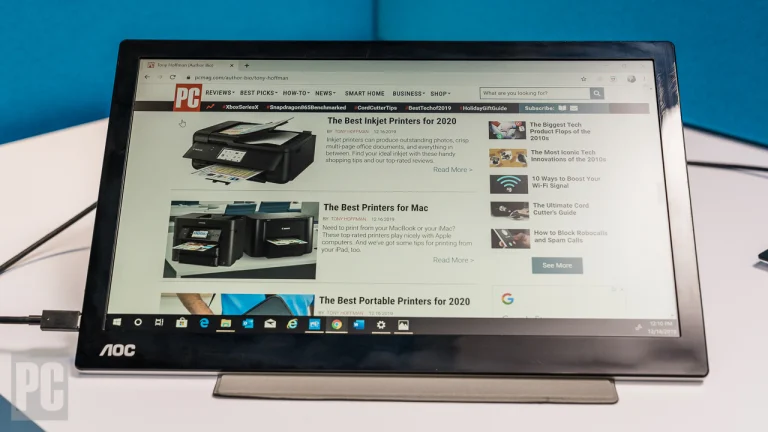
(Credit: Zlata Ivleva)
Some portable monitors make use of conventional power adapters. This is especially true for devices designed for artists that function with sketch pens; they are essentially interactive monitors. Typically, an adapter powers the display, and two cables are used to connect it to the computer. The device’s picture is sent via HDMI, and the user’s pen movements are recorded by USB (via a USB-A connector) when they draw on the interactive display. On more traditional portable screens, HDMI (sometimes in the form of mini-HDMI) is also a popular port—the most prevalent, aside from USB-C.
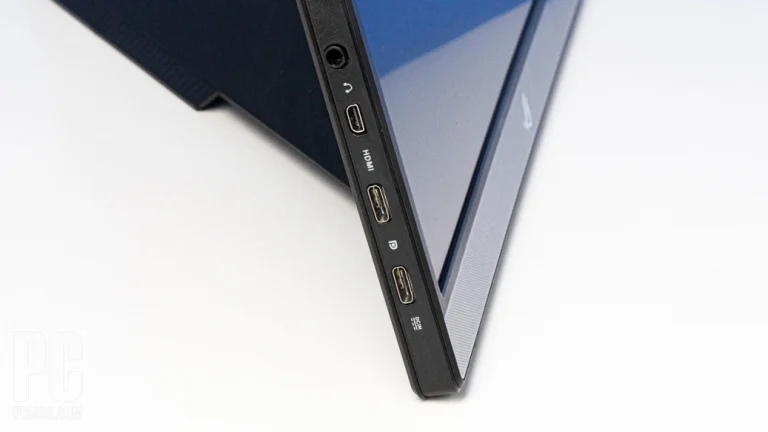
(Credit: Molly Flores)
A few older portable display models still use a separate USB 3.0 connection to get power from a laptop, however USB-C has rendered this type of connection outdated.
Portable Monitor Software and the On-Screen Display
Most portable monitors just need to be plugged in and turned on; no software is needed to use them. Any utilities that are provided will be for specialized purposes, such making the screen picture stay in an upright position when you go from portrait to landscape mode. Occasionally, a tool built into the display allows you to adjust the monitor’s settings directly from your computer screen, bypassing the secondary panel’s on-screen display (OSD) controls.
The menu system of the display, known as the OSD, controls aspects including brightness, contrast, color levels, image mode, and aspect ratio that are adjustable by the user. It is frequently set up with many submenus. It is more typical for models to have a single button or switch to control the OSD, while some come with multiple buttons.
When it comes to mobile monitors, audio is usually not a factor because these devices often don’t have built-in speakers or audio connections. In our experience, the few portable screens (often gaming versions) that do come with speakers are poor quality ones, and they work best when combined with a smartphone or a portable game console. You may always change the audio source from the display to your laptop when the monitor is linked to a laptop by selecting the speaker icon in the taskbar (in Windows).
Ready to Buy the Right Portable Monitor for You?
There is a model out there that suits your demands and price; the important thing is to make sure it matches well with the primary display panel you’ll be utilizing alongside it. For the best portable screens available right now that we’ve tested, check out our product recommendations above along with our extensive specs list. We often update this story, but check out our comprehensive guide to the best monitors for the most recent evaluations we’ve provided.

